| 9 February |
• yesterday • tomorrow |
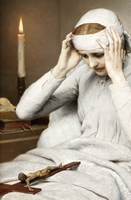
Anne Catherine Emmerick
Born to poor but pious peasants. She was a very pious child who suffered with poor health, but who received visions and prophesies; they were so common that she thought all children could see the Child Jesus and the souls in Purgatory. She was able to diagnose illness and recommend cures, and to see a person's sins.
She worked on her family's and other area farms, as a seamstress, and as a servant to a poor organist where she studied the instrument. Entered the Augustinian convent at Agnetenberg, Dulmen, Germany in 1802. Though her health was poor, her enthusiasm for the religious life was great, and she either energized her sisters, or put them off badly. Given to going into religious ecstasies in church, her cell, or while working.
The convent was closed by government order in 1812, and Anne moved in with a poor widow. Her health failed, and instead of working as a servant, in 1813 she became a patient. Her visions and prophesies increased, and later that year she received the stigmata with wounds on her hands and feet, her head from the crown of thorns, and crosses on her chest, and the gift of inedia, living off nothing but Holy Communion for the rest of her life. She tried to hide the wounds, but word leaked out, and her vicar-general instituted a lengthy and detailed investigation; it was determined to be genuine.
In 1818 she was relieved of the stigmata. In 1819 the government opened their own investigation. She was imprisoned, threatened, cajoled, and kept under 24-hour-a-day surveillance. The commission found no evidence either way, could not get Anne to change her story, eventually gave up, and failed to publish their findings. When they were forced to report, they declared the incident a fraud, but could not explain why they thought so, or why they had not published their findings.
The poet Klemens Brentano visited Anne. She announced that she had seen Brentano in a vision, and that he was to make a written record of the revelations that she received. He made notes of the messages, translating from Anne's Westphalian dialect to common German, getting Anne to confirm his version. In 1833 these were published as The Dolorous Passion of Our Lord Jesus Christ according to the Meditations of Anne Catherine Emmerich. This was followed in 1852 by The Life of The Blessed Virgin Mary, and a three-volume Life of Our Lord from 1858 to 1880. While many such revelatory works deal with spirituality and ideas, these are very much straight-forward narratives and descriptions of events, yet have been the source of encouragement for many.
Her Cause for Canonization formally introduced on 14 November 1892. Due to accusations about her vow of chastity, the investigation was halted on 30 November 1928. However, the accusations were proven false, and the investigation resumed on 18 May 1973.
8 September 1774 at Flamsche, diocese of Münster, Westphalia, Germany
• 9 February 1824 at Dülmen, Germany
• due to rumours that her body had been stolen, her grave was opened six weeks after her death
• the body was found incorrupt
• relics translated to Holy Cross Church, Dülmen, Germany on 15 February 1975
• 3 October 2004 by Pope John Paul II
• decree of beatification miracle promulgated on 7 July 2003
bed-ridden stigmatist
• Nativity of Our Lord Jesus Christ - read online, download in EPub
• The Dolorous Passion of Our Lord Jesus Christ
• The Life of Jesus Christ and Biblical Revelations
• The Lowly life and Bitter Passion of Our Lord Jesus Christ and His Blessed Mother
• The Life Of Jesus Christ And Biblical Revelations Complete
• Mary Magdalen in the Visions of Anne Catherine Emmerich
• Life of the Blessed Virgin Mary
The Church is the only one, the Roman Catholic! And if there were left upon earth but one Catholic, he would be the one, universal Church, the Catholic Church, the Church of Jesus Christ against which the gates of Hell shall never prevail. - Blessed Anne
If the Church is true, all in her is true; he who admits not the one, believes not the other. - Blessed Anne
Blessed Anna Katharina Emmerick showed and experienced in her own flesh "the bitter passion of Our Lord Jesus Christ." The fact that, from being the daughter of poor peasants, who constantly sought closeness to God, she became the famous "mystic of Muenster" is a work of divine grace. Her material poverty is contrasted with her rich interior life. As much as by her patience to endure her physical weaknesses, we are impressed by the strength of character of the new blessed and her firmness in the faith. She received this strength from the Holy Eucharist. In this way, her example opened the hearts of poor and rich men, educated and humble people, to complete loving passion toward Jesus Christ. Still today she communicates to all the salvific message: "By his wounds you have been healed" (see 1 Peter 2:24). - Pope John Paul II, homily at the beatification of Blessed Anne, 3 October 2004
https://catholicsaints.info/blessed-anne-catherine-emmerich/
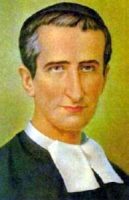
• Francisco Luis Febres Cordero Muñoz
• Michael Febres Cordero
• Miguel of Ecuador
Born to a prominent family, he had an unknown disability, and was unable to stand until age five when he received a vision of Our Lady. At age eight he was miraculously protected from being mauled by a wild bull. In 1863, at age nine, he enrolled in a school run by the Christian Brothers, an Order which had only recently come to Ecuador. Miguel joined the Brothers on 24 March 1868 at age 13.
School teacher at El Cebollar School in Quito, a position he held for 32 years. A gentle, dedicated, and enthusiastic teacher. Wrote his own textbooks, the first at age 17; some were adopted by the government, and used throughout the country. Wrote odes, hymns, discourses on teaching methods, plays, inspirational works, and retreat manuals. Elected to the Ecuadoran Academy of Letters in 1892, followed soon after by the Academies of Spain, France, and Venezuela. Conducted religious retreats, and prepared children for their First Communion. Novice director for his house from 1901 to 1904.
Sent to Europe in 1905 to translate texts from French to Spanish for use by the Order; worked primarily in Belgium. His health began to fail in 1908, and he was transferred to the school near Barcelona, Spain. He continued to work, but slowly, his health continued to fail, and he died there in 1910. In addition to being a religious role model, Miguel is considered a national hero in Ecuador for his success in so many worthwhile areas.
7 November 1854 at Cuenca, Ecuador
• 9 February 1910 of pneumonia at Premia del Mar, Spain, and buried there
• grave disturbed during the Spanish Civil War, and his body found incorrupt
• re-interred in Quito, Ecuador
• his tomb has become a pilgrimage site
21 October 1984 by Pope John Paul II
The heart is rich when it is content, and it is always content when its desires are fixed on God. - Saint Miguel
https://catholicsaints.info/saint-miguel-febres-cordero-munoz/
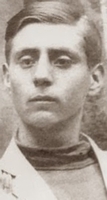
Lifelong layman in the archdiocese of Guadalajara. Active member of the Catholic Association of Mexican Youth. Member of the Archconfraternity of the Night Adoration of the Blessed Sacrament and the Our Lady of Guadalupe Association of tradesmen in his parish. He grew up helping his father in the family's leather tannery, and was a baseball fan. Married to Elvira Camarena Méndez on 6 January 1926, they had a son named Gilberto.
On 9 February 1928, in the persecutions of the Mexican Revolution, troops were ordered to arrest Luis as a Cristero, that is, a Christian who fought against the government; his home town of Arandas was a hotbed of resistance. He was away when the soldiers came to his house, so the troops arrested his brother. When he learned of this, Luis turned himself in, his brother was freed, and Luis was immediately sentenced to death. Martyr.
Elvira was pregnant at the time, and their daughter, Maria Luisa, was born after the death of her father.
24 August 1902 in Arandas, Jalisco, Mexico
shot by firing squad at 3pm on 9 February 1928 in Arandas, Jalisco, Mexico
20 November 2005 by Pope Benedict XVI
I have never been a rebellious Cristero as you believe, but if I am accused of being a Christian, then yes, I am, and if for this I have to be killed, welcome. Long live Christ the King and Saint Mary of Guadalupe! – Blessed Luis to the commanding officer when he surrended to the government troops
I want to tell you that from this moment I forgive you and I promise you that as soon as I am in the presence of God you will be the first for whom I will intercede. – Blessed Luis' dying words to the soldiers who were about to shoot him
https://catholicsaints.info/blessed-luis-magana-servin/
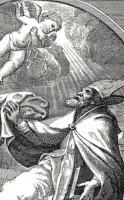
Rinaldo
Born to the nobility, the eldest son of the the Count of Postignano. He received a good eduction, and his family expected him to have a life in politics, but Raynald felt a call to religious life. He gave away all his possessions and withdrew from the world to live as a hermit on the mountain of Serrasanta near Gualdo Tadino, Italy. Benedictine Camaldolese monk at Fonte-Avellana, Umbria, Italy. Chosen prior of his monstery. Bishop of Nocera, Italy from 1209 to 1213, he worked in the Roman Curia. Titular bishop of Nocera. Noted for his charity to the poor, he was also involved in the promulgation of Indulgence of Portiuncula in August 1216.
c.1150
• 9 February 1217 in Nocera, Umbria, Italy of natural causes
• body discovered incorrupt
• relics enshrined in an urn in the church of Santa Maria dell'Arengo
• relics enshrined in the cathedral of Santa Maria Assunta in 1456
• relics moved to the church of San Felicissimo on 26 September 1997 following earthquake damage to the cathedral
• popular devotion and reports of miracles begin soon after the death of Raynald
• Bishop Pelagio Pallavicini approves the cultus in late 1217
• when his body was discovered to be incorrupt, he was chosen patron of Nocera
• declared co-patron of the diocese of Nocera in 1448
• Assisi-Nocera Umbra-Gualdo Tadino, Italy, diocese of
• Nocera, Italy
https://catholicsaints.info/saint-raynald-of-nocera/
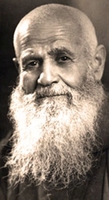
• Francisco Tomás Márquez Sánchez
• Francisco Tomás de San Juan Bautista Márquez y Sánchez
• Leopoldo de Alpandeire
The eldest of four children in a rural peasant family, Francisco was baptized at the age of five days, and grew up in a peasant family, tending the sheep and goats in a small village in southern Spain. He became Capuchin monk in Granada, Spain at age 33 after hearing the preaching of some Capuchin friars; he wore the cowl for over 56 years. He served as a beggar for his house, roaming the city, asking for donations, praying for any who sought his counsel or blessing. Known for his piety and wisdom, his was an example of the quiet Christian life of virtue.
24 June 1866 at Alpandeire, Málaga, Spain as Francisco Tomás de San Juan Bautista Márquez y Sánchez
• 9 February 1956 in Granada, Spain of pneumonia following a severe injury from falling down a flight of stairs
• buried in the crypt of the church at his friary in Granada
• 12 September 2010 by Pope Benedict XVI
• beatification recognition celebrated at the Armilla Air Base, Granada, Spain, presided by Archbishop Angelo Amato
https://catholicsaints.info/blessed-francisco-sanchez-marquez/
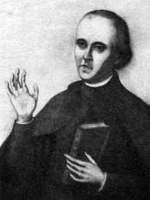
Second of six children born to Carlo Benedetto Abbondo and Francesca Maria Naya. Giacomo was greatly influenced by his paternal uncle, Father Giovanni Carlo Abbondo. Studied in Tronzano and Vercelli in Italy. Ordained in the diocese of Vercelli on 21 March 1744; he received dispensation for the ordination from Pope Clement XII as he was still under age. Obtained a degree in literature in Turin, Italy on 31 October 1748. Taught in Vercelli, but left teaching in 177 to serve as parish priest in Tronzano. Known as an excellent preacher, he revitalized the faith life of his flock, endlessly visiting parishioners, leading retreats, and developing a reputation for holiness.
27 August 1720 in Salomino, Duchy of Milan (in modern Italy)
• 9 Febuary 1788 in Tronzano, Ducky of Milan, Italy of natural causes
• buried in Tronzano
• due to his grve becoming a site of pilgrimage, his was re-interred on 13 March 1922
• relics exhumed and enshrined in his old parish church on 5 November 2015
• 11 June 2016 by Pope Francis
• beatification celebrated at the Cathedral of Sant'Eusebio, Vercelli, Italy presided by Cardinal Angelo Amato
• his beatification miracle involved the 1907 healing of Giovanni Domenico Viola received through the intercession of Father Giacomo
Tronzano, Italy
https://catholicsaints.info/blessed-giacomo-abbondo/
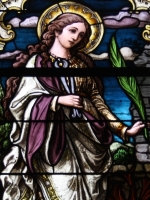
Apolline of Alexandria
Consecrated virgin. Deaconess. During an anti-Christian uprising in Alexandria, Egypt caused by a pagan prophecy, the mob seized Apollonia as a leader among the local Christians. After her teeth were broken with pincers, she was given the choice of renouncing Christ or being burned alive; she lept onto the fire herself. Martyr.
burned to death c.249 at Alexandria, Egypt
• against tooth disease
• against toothache
• dental technicians
• dentists
• 3 cities
• deaconess holding a set of pincers which often holds a tooth
• gilded tooth
• pincers
• pincers grabbing a tooth
• tooth
• tooth and a palm branch
• woman wearing a golden tooth on a chain
https://catholicsaints.info/saint-apollonia-of-alexandria/
• Marianus of Ireland
• Muirdach MacRobartaigh
• Murdoch MacGroarty
• Muiredach MacGroarty
Pilgrim to Rome, Italy in 1067, but he never made it. As he passed through Michaelsberg, Germany, he was asked to help copy some manuscripts for a convent. With his travelling companions working to make the vellum on which he wrote, he stayed for the work, and became a Benedictine monk at Michelsberg Abbey, and then at the Upper Minster, Ratisbon, Bavaria (in modern Germany). Founded Saint Peter's abbey at Ratisbon in 1078, and served as its first abbot. This house began the congregation of twelve monasteries in southern Germany staffed by holy men from the British Isles. Marianus spent any free time copying manuscripts, including the Bible, and was known as a exceptional calligrapher; some of his manuscripts survive today.
Legend says that one evening the woman who prepared lamps for Marianus suddenly overslept. She woke some others to help her and went to Marianus's room. Marianus sat without lamp or candle, writing with his right hand, holding his other in the air. A light shone from left hand, illuminating his work, and the ladies left him in peace.
early 11th century in County Donegal, Ireland
10 February 1088 at Ratisbon (Regensburg), Germany
https://catholicsaints.info/blessed-marianus-scotus/
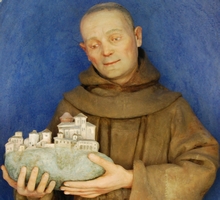
Franciscan friar at the convent of Sant'Angelo in Milan, Italy. Superior of a community in Lodi, Italy. His gifts as an administror led to him being appointed commissioner of the holy places in the Holy Land in 1478.
Back in Europe, Brother Bernardino got the idea of reproducing the holy sites of Palestine to give Christians a chance to make devotional pilgrimages without the dangerous trip to the Holy Land. His idea was a representation of the life and death of Jesus so that pilgrims could see and meditate on them, similar to the Stations of the Cross, but covering all aspects of Christ's life and death. In 1491, with the financial support, he began construction of Sacro Monte di Varallo near Varallo Sesia, Italy. It includes a minor basilica, 45 chapels, paintings and frescoes, and 800 wooden and terracotta life-sized statues of people depicting the life, Passsion, death and resurrection of Christ.
early 15th century in Italy
9 February 1500 of natural causes
https://catholicsaints.info/blessed-bernardino-caimi/
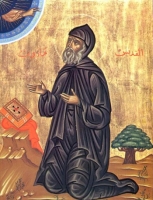
• Maro of Beit-Marun
• Maron, Marone, Maroun
Hermit who lived near the Orontes River at Cyrrhus, generally in the open with no shelter. When he found a pagan temple, he dedicated it to God and made it his oratory. Ordained in 405. Spent his nights standing in prayer. Had the gift of healing, both physical ills and of vices. Founded monasteries and trained monks in Syria. Friend of and greatly revered by Saint John Chrysostom. Spiritual teacher of Saint Limnaeus. The Maronite Christians take their name from the saint.
350 in Syria
• 433 of natural causes
• buried between Apamea and Emesa, where a monastery grew up around his tomb
• Maronite Christians
• Saint Maron of Brooklyn for the Maronites, eparchy of
• Saint-Maron de Montréal, Québec, diocese of
• Volperino, Italy
https://catholicsaints.info/saint-maro/
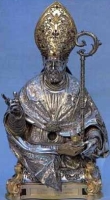
• Sabino of Atripalda
• Sabino of Avellino
16 September (translation of relics)
Bishop of Abellinum, an ancient imperial Roman city whose ruins are found in modern Atripalda, Italy, which is now part of the city of Avellino, in the late 5th and early 6th centuries. He led his people during the period of the Ostrogoth invasions. Saint Romulus served as his deacon.
• early 6th century of natural causes
• relics enshrined in the church of Saint Ipolisto in Atripalda, Italy in the late 16th century
• relics re-interred in the Specus martyrum, a monument in the cemetery of the church of Saint Ipolisto in Atripalda on 16 September 1612
Atripalda, Italy
with Saint Romulus and Saint Ipolisto
https://catholicsaints.info/saint-sabino-of-abellinum/
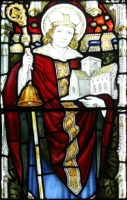
Dillo, Dillon, Dol, Elidius, Elios, Eliud, Teilan, Teilio, Teilou, Teilus, Teio, Teiou, Teliano, Teliarus, Teliavo, Teliou, Thelian, Theliau
Son of Ensic and Guenhaff; brother of Queen Anaumed of Cornwall. Spiritual student of Saint Dyfrig of Wales. Friend of Saint David of Wales and Saint Samson of York. Founded Llandaff monastery in Dyfed, Wales. Bishop of Llandaff in 495.
Penally, Wales
• 6th century
• buried at Landeio Fawr, Dyfed, Wales
• some relics at Landeio Fawr, Dyfed, Wales
• some relics at Llandaff, Wales
• some relics at Penally, Wales
• against fever
• horses
man riding a deer
https://catholicsaints.info/saint-teilo-of-llandaff/
Braque
Courtier in service to Count Sigivald of Clermont, and a man who loved hunting. One day as he was hunting a wild boar, the animal ran into the hut of a hermit named Emilien where it knew it was safe. Brachio became interested in the man, and after time with him, he became interested in religious life. Soon afterwards he gave up the worldly life and spent two years as a spiritual student of Emilien. Other would-be students were attracted to the hermitage, and after Emilien's death, Brachio turned the place into a monastery and served as its first abbot.
Touraine, France
576 in Auvergne, France
https://catholicsaints.info/saint-brachio-of-auvergne/
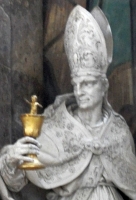
• Alto of Ireland
• Alton...
5 September (British Isles)
Hermit in a forest near Augsburg, Germany. His reputation for holiness attracted would-be spiritual students; to house them he founded a monastery that was later known as Altomünster in his honour. The town of Altomünster grew up around it.
in Ireland
c.760 in Bavaria, Germany of natural causes
https://catholicsaints.info/saint-alto-of-altomunster/
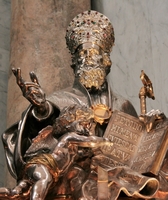
Bishop of Canosa, in the Apulia region of southern Italy. Friend of Saint Benedict of Narsia. Papal legate for Pope Saint Agapitus I to the court of Emperor Justinian at Constantinople from 535 to 536. Sabinus went blind in his later years.
• 556 of natural causes
• relics at Bari, Italy
• Andria, Italy, diocese of
• Bari, Italy
• Bari-Bitonto, Italy, archdiocese of
• Canosa di Puglia, Italy
https://catholicsaints.info/saint-sabinus-of-canosa/
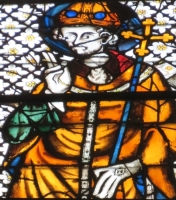
• Ansbert of Fontenelle
• Ansberto, Aubert
Chancellor at the court of King Clotaire III. Married; with his wife's permission, he retired to become a Benedictine monk at Fontenelle in Normandy, France. Abbot of Fontenelle. Archbishop of Rouen, France in 683. Exiled to Hainaut by Pepin of Heristal.
at Chaussy-sur-Epte, France
695 at Hainaut (part of modern Belgium) of natural causes
https://catholicsaints.info/saint-ansbert-of-rouen/
Godeschalcus, Godeskalk, Gottschalk
Premonstratensian canon in Steinfield, Germany. He led a group of Premonstratensian brothers who revived an abandoned Benedictine monastery of Želiv (in modern Czech Republic); it became one of the most important religious institutions in Bohemia, and its brothers founded other houses throughout the region. Spiritual teacher of Blessed Gerlac of Milevsko.
c.1126 in Cologne, Germany
• 9 February 1184 in Zeliv, Czech Republic
• buried in the abbey church at the monastery there
https://catholicsaints.info/blessed-godeschalk-of-zeliv/
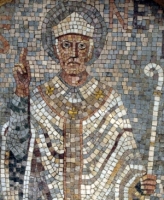
Nebridi, Nebridio
Brother of Saint Justus of Urgell, Saint Elpidius of Huesca and Saint Justinian of Valencia. Bible scholar and commentator. Benedictine monk. Priest. Attended the Council of Tarragona in 516, the Council of Girona in 517, the 2nd Council of Toledo in 527, and probably the Council of Barcelona in 540. Bishop of Egara, Spain from 516 to 527. Bishop of Barcelona, Spain from 540 to c.545.
Girona, Spain
c.545
https://catholicsaints.info/saint-nebridius-of-egara/
Auedeberto, Ausberto, Autberto, Autbertus
Bishop of Senlis, France. The exact dates have been lost, but there are documents with his signature between 652 and 667. Late in life he apparently retired from his see to spend his last days as a prayerful monk.
early 7th century in Senlis, France
• late 7th century of natural causes
• interred under the high altar of the church of Saint Regulus in Senlis, France
https://catholicsaints.info/saint-auedebertus-of-senlis/
Curvinus, Cronan
Bishop in Ireland. When the requirements of the office crowded out his prayer life, Cuaran moved to Iona, hid his identity, and became a monk. However, he was recognized by Saint Columba and returned to his duty. Called "the Wise" due to his extensive knowledge of the canons of the Church.
c.700
https://catholicsaints.info/saint-cuaran-the-wise/
Augustinian Canon Regular at the abbey of Rottenbuch, Germany. He helped found the canonry at Neuwerk bei Halle, Saxony (in modern Germany) c.1116, and served as its provost until his death.
1123 of natural causes
https://catholicsaints.info/blessed-lambert-of-neuwerk/
First spiritual student of Saint John Gualbert. Vallombrosan monk. Fourth superior-general of the Vallombrosans.
in Florence, Italy
1094 of natural causes
1600 by Pope Clement VIII (cultus confirmation)
https://catholicsaints.info/blessed-erizzo/
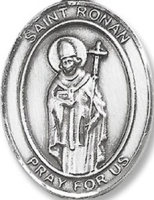
Eighth century bishop of Lismore, Ireland. Several churches in Munster, Ireland are named for him. Confessor of the faith.
https://catholicsaints.info/saint-ronan-of-lismore/
Anianus, Einion, Eneon, Eingan, Einganor
Sixth century British prince in Cumberland who abdicated to live as a hermit at Llanengan near Bangor, Wales.
https://catholicsaints.info/saint-eingan-of-llanengan/
Following his public confession of Christianity, Alexander was martyred with 38 companions whose names have not come down to us.
in Rome, Italy
https://catholicsaints.info/saint-alexander-of-rome-0209/
An unknown number of Christians who were massacred in church in 4th century Alexandria, Egypt by Arian heretics for adhering to the orthodox faith.
https://catholicsaints.info/martyrs-of-alexandria-9-february/
Niceforus
Martyred in the persecutions of Valerian.
c.260 at Antioch, Syria
https://catholicsaints.info/saint-nicephorus-of-antioch/
Deacon. Martyred by Donatist heretics for his defense of orthodox Christianity.
362 in Lavallum, North Africa
https://catholicsaints.info/saint-donatus-the-deacon/
Deacon. Martyred by Donatist heretics for his defense of orthodox Christianity.
362 in Lavallum, North Africa
https://catholicsaints.info/saint-primus-the-deacon/
Fifth century hermit who lived on a mountain near Antioch, Syria.
https://catholicsaints.info/saint-romanus-the-wonder-worker/
Martyr.
https://catholicsaints.info/saint-alexander-of-soli/
Martyr.
https://catholicsaints.info/saint-ammonius-of-soli/
A group of 44 Christians martyred together. We know little else about them except some of their names -
• Ammon
• Didymus
• Emilian
• Lassa
• Poemus
in Membressa in Africa
• Our Lady of the Bells
CatholicSaints.Info Portable Edition